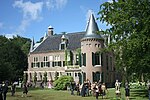Keukenhof

Keukenhof (English: "Kitchen garden"; Dutch pronunciation: [ˈkøːkə(n)ˌɦɔf]), also known as the Garden of Europe, is one of the world's largest flower gardens, situated in the municipality of Lisse, in the Netherlands. According to the official website, Keukenhof Park covers an area of 32 hectares (79 acres) and approximately 7 million flower bulbs are planted in the gardens annually. Keukenhof is widely known for its tulips, and it also features numerous other flowers, including hyacinths, daffodils, lilies, roses, carnations and irises.Keukenhof is located in the province of South Holland, south of Haarlem and southwest of Amsterdam in the area called the "Dune and Bulb Region" (Duin- en Bollenstreek). It is accessible by bus from Haarlem and Leiden train stations as well as Schiphol. Though its grounds are open year-round for private affairs and festivals, Keukenhof is only open to the general public for a world-renowned 8 week tulip display from mid-March to mid-May, with peak viewing arriving near mid-April, depending on growing season weather, which varies annually. In 2019, 1.5 million people visited Keukenhof, equivalent to 26,000 visitors per day. By comparison, the Rijksmuseum receives an average of 8,000 visitors per day, the Efteling receives 14,000.
Excerpt from the Wikipedia article Keukenhof (License: CC BY-SA 3.0, Authors, Images).Keukenhof
Keukenhof,
Geographical coordinates (GPS) Address Website External links Nearby Places Show on map
Geographical coordinates (GPS)
| Latitude | Longitude |
|---|---|
| N 52.271256 ° | E 4.546365 ° |
Address
Keukenhof
Keukenhof
2161 AM
South Holland, Netherlands
Open on Google Maps










